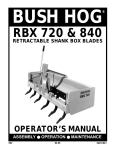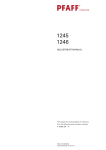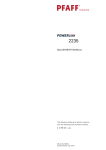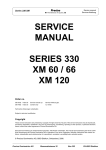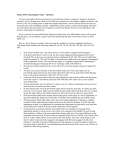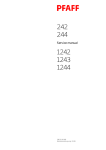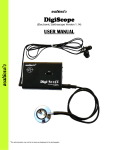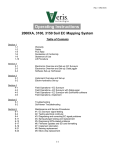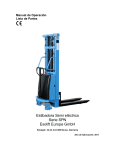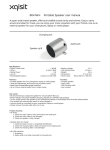Download Service Manual for the series 480, 560 and 950
Transcript
-900/51 -900/57 Service Manual for the series 480, 560 and 950 296-12-17 607 Justieranleitung dtsch. 06.95 At the time of printing, all information and illustrations contained in this document were up to date. Subject to alteration The reprinting, copying or translation of PFAFF Service Manuals, whether in whole or in part, is only permitted with our previous agreement and with written reference to the source. G.M. PFAFF Aktiengesellschaft Postfach 3020 D-67653 Kaiserslautern Königstr. 154 D-67655 Kaiserslautern Editing / Illustration HAAS-Publikationen GmbH D-53840 Troisdorf Table of Contents Contents ............................................................................... Chapter - Page 1 1.01 1.02 1.03 Safety ..................................................................................................... 1 General notes on safety ............................................................................................ 1 Safety symbols ......................................................................................................... 1 Danger ....................................................................................................................... 1 2 2.01 2.02 2.03 2.04 2.05 2.06 2.07 2.08 2.09 2.10 2.11 2.12 2.13 2.14 2.15 2.16 2.17 2.18 2.19 Adjustment ............................................................................................. 2 - 1 Notes on the service manual .................................................................................... 2 - 1 Tools, gauges and other accessories ........................................................................ 2 - 1 Abbreviations ............................................................................................................. 2 - 1 Work symbols ........................................................................................................... 2 - 1 Pre-adjusting the control cam ................................................................................... 2 - 2 Roller lever................................................................................................................. 2 - 3 Pawl ........................................................................................................................... 2 - 4 Engaging solenoid ...................................................................................................... 2 - 5 Release lever ............................................................................................................. 2 - 6 Engaging lever ........................................................................................................... 2 - 7 Lateral adjustment of the thread catcher ................................................................. 2 - 8 Front reversal point of the thread catcher ................................................................ 2 - 9 Re-adjusting the control cam .................................................................................... 2 - 10 Retaining spring ......................................................................................................... 2 - 11 Knife to needle clearance .......................................................................................... 2 - 12 Manual trimming check ............................................................................................ 2 - 13 Tension release of needle thread .............................................................................. 2 - 14 Positioner ................................................................................................................... 2 - 15 Mounting and dismounting the control unit .............................................................. 2 - 16 - 1 1 2 2 Safety 1 Safety 1.01 General notes on safety ● This machine must only be operated by adequately trained operators and only after having completely read and understood the Instruction Manual! ● All Notes on Safety and Instruction Manuals of the motor manufacturer are to be read before operating the machine! ● The Danger and Safety Instructions on the machine itself are to be followed! ● The machine must be used only for the purpose for which it is intended and must not be operated without its safety devices. Observe all relevant safety regulations! ● When exchanging sewing tools (e.g. needle, presser foot, needle plate, feed dog and bobbin), when threading, when the workplace is left unattended and during servicing, the machine must be disconnected from the mains by switching off the on/off switch or by removing the plug from the mains! ● Daily servicing work must be carried out only by appropriately trained persons! ● Repairs and special maintenance work must only be carried out by technicians or persons with appropriate training! ● For service or repair work on pneumatic systems the machine must be disconnected from the compressed air supply. The only exceptions to this are adjustments and function checks made by appropriately trained personnel! ● Work on the electrical equipment must be carried out only by electricians or appropriately trained personnel! ● Work is not permitted on parts and equipment which are connected to the power supply! Exceptions to this are contained in the regulations EN 50110! ● Modifications and alterations to the machine must only be carried out under observance of all the relevant safety regulations! ● Only spare parts which have been approved by us are to be used for repairs! We expressly point out that any replacement parts or accessories which are not supplied by us have not been tested and approved by us. The installation and/or use of any such products can lead to negative changes in the structural characteristics of the machine. We shall not be liable for any damage which may be caused by non-original parts! 1-1 Safety 1.02 Safety symbols Danger! Points to be observed. Danger of injury to operating and specialist personnel! 1.03 Danger Do not reach into the sewing area while sewing! Danger of injury caused by needle! Do not leave any objects on the table or near the needle plate while carrying out adjusting work. Objects can become jammed or be slung away! Danger of injury! In order to adjust this device, the machine must be tilted to the back. Use both hands when returning the machine to an upright position! Danger of crushing between sewing head and table top! 1-2 Adjustment 2 Adjustment Please observe the safety instructions of this service manual as and the notes on safety in the instruction manual before carrying out any maintenance or adjustment work. On the 480 series no c-clamps may be attached to the needle bar as this would damage the special coating on the needle bar. Refer to the motor manufacturer’s instruction manual for the setting of the cutting torque (180 min-1). 2.01 Notes on the service manual All adjustments in this servicing manual apply to a fully assembled machine. Covers on the machine which have to be removed and replaced for checking and adjustment work are not mentioned in the text. Screws and nuts mentioned in brackets () are to be loosened before making an adjustment and tightened again when the adjustment is complete. 2.02 Tools, gauges and other accessories ● Screw drivers with blade widths from 2 to 10 mm ● Wrenches with jaw widths from 7 to 14 mm ● Allan keys from 1.5 to 6 mm ● Metal rule, part no. 08-880 218-00 ● Rig pin (diameter: 5 mm), part no. 13-030 341-05 ● Clearance control device ● Sewing thread 2.03 Abbreviations t.d.c = top dead centre b.d.c. = bottom dead centre 2.04 Work symbols Note, information Servicing, repair, adjusting, maintenance 2-1 Adjustment 2.05 Pre-adjusting the control cam Requirements At the t.d.c of the needle bar, 1. the beginning of the highest point of the trip of the control cam 6 sould be positioned under the tip of pawl 8 and 2. the right-hand side of the trip should be flush with the right-hand side of pawl 8. 4 6 5 7 5 4 1 % V 24 2 =4 ED 3 8 6 2-02 Fig. 2 - 01 ● Pull the ball heads of connecting rod 1 off the ball pin at the cutting and control units and remove connecting rod 1. ● Loosen screws 2 and retaining spring 3 together with the cover disk. ● Loosen screws 4 and 5. ● Twist or shift control cam 6 in accordance with requirement 1 or requirement 2 as required. ● Tighten screws 4 firmly. ● Push fixing collar 7 onto control cam 6. ● Tighten screws 5 firmly. Connecting rod 1 and retaining spring 3 stay dismantled for further adjustments. 2-2 Adjustment 2.06 Roller lever Requirements When the needle bar is positioned 1.8 mm after the b.d.c, 1. the roller of the roller lever 4 should engage easily with the control cam 7 and 2. the roller of roller lever 4 should be centred in the cam notch of the control cam 7 4 7 3 1 5 2 V 6 24 = 4% ED 7 4 2-03 Fig. 2 - 02 ● Unscrew screws 1 and 2. ● Put pressure on rockshaft 3 to the right. ● Adjust roller lever 4 in accordance with requirements 1 and 2. ● Tighten screw 1 firmly. ● Position the surface of the fixing collar 5 (bolt 6) parallel to the base plate. Screw 2 stays undone for the following adjustment. 2-3 Adjustment 2.07 Pawl Requirement With the thread trimmer in resting position, the distance between pawl 2 and the highest point of the control cam should be 0.3 mm. 1 2 % V 24 =4 ED 3 0.3 mm 2 1 3 4 3 2-04 Fig. 2 - 03 ● Position the bearing surface of control cam 1 with its highest point below pawl 2 by turning the hand wheel. ● Shift pin 3 (screw 4) in accordance with the requirement. 2-4 Adjustment 2.08 Engaging solenoid Requirement When the needle bar is positioned 1.8 mm after the b.d.c and the engaging solenoid is actuated, the distance between the engaging lever 1 and the pawl 2 should be between 0.2 and 0.3 mm. % V 24 ED =4 4 3 2 1 0.2 m 0.3 m 2-05 Fig. 2 - 04 ● Position the needle bar 1.8 mm after b.d.c ● Manipulate engaging lever 1 until pawl 2 engages. ● Push magneto inductor into the magnet housing 3 as far as possiblt and move magnet housing 3 (screw 4) together with the magneto inductor in accordance with the requirement. 2-5 Adjustment 2.09 Release lever Requirement When the needle bar is positioned 1.8 mm after the b.d.c and the engaging lever 1 is actuated, the distance between the roller of the roller lever 2 and the bottom of the control cam 3 must be approx. 0.2 mm. 5 % V 24 2 ED 4 =4 0.2 mm 4 1 3 2-06 Fig. 2 - 05 ● Position needle bar 1.8 mm after b.d.c ● Activate engaging lever 1 manually. ● Push roller lever 2 onto the bottom of control cam 3. ● Tighten screw 5 slightly. ● Push release lever 4 onto engaging lever 1. ● Adjust the distance to control cam 3 to approx. 0.2 mm by tapping the roller lever 2 and measuring repeatedly with lever 4 which must be in constant lateral contact with roller lever 2. ● Tighten screw 5 firmly. 2-6 Adjustment 2.10 Engaging lever Requirement When the needle bar is at the t.d.c and the thread trimmer is in resting position, the distance between the roller of the roller lever 3 and the outer diameter of the control cam 4 should be between 0.3 and 0.5 mm. % V 24 ED =4 0.3 - 0.5 mm 3 4 2-07 Fig. 2 - 06 ● Turn screw 1 (nut 2) in accordance with the requirement. ● Check distance in accordance with the requirement. 2-7 2 1 Adjustment 2.11 Lateral adjusting of the thread catcher Requirement 1. The tip of the thread catcher 6 should point exactly to the middle of the needle. 2. The thread catcher 6 should not touch anywhere when in motion. 6 5 4 2 1 3 6 2-08 Fig. 2 - 07 ● Unscrew needle plate and feed dog. ● Loosen screw 1 and remove knife 2. ● Position needle bar at b.d.c ● Push aside catcher stop 3 (screws 4). ● Loosen screws 5. ● Position the tip of thread catcher 6 in front of the needle by moving the thread catcher carrier. ● Adjust thread catcher 6 laterally in accordance with requirement 1. ● Tighten screws 5 firmly ensuring that the back of the thread catcher is horizontal. Needle plate, feed dog, knife 2 and catcher stop 3 stay dismantled for the following adjustments. 2-8 Adjustment 2.12 Front reversal point of the thread catcher Requirement In the front reversal point of the thread catcher 3 the rear edge of thread catcher cutout should be 1 mm in front of the bobbin case position finger 4. 2 1 2 4 1 mm 3 2-09 Fig. 2 - 08 ● Push balls of the connecting rod 1 onto the ball pins on the cutting and control units. ● Loosen nuts 2 (right-hand and left-hand thread). ● Position needle bar at t.d.c ● Activate the engaging lever manually. ● Bring thread catcher 3 to its front point of reversal by turning the hand wheel. ● Turn connecting rod 1 in accordance with the requirement. ● Lock connecting rod 1 by means of nuts 2. 2-9 Adjustment Re-adjusting the control cam Requirement When the end of the hook plate 1 is positioned 2 mm behind the middle of the lug of the bobbin case position finger, the distance between the tip of the thread catcher 6 and the middle of the lug should also be 2 mm. 4 5 3 4 % V 1 ED =4 2 mm 24 2 6 2 mm 2.13 2-11 Fig. 2 - 09 ● Position the needle bar at b.d.c ● Activate the engaging lever manually. ● Turn the hand wheel until the distance between the end of hook plate 1 and the middle of the lug of the bobbin case position finger 2 is 2 mm. ● Turn control cam 3 (screws 4) in accordance with the requirement and bring it into contact with fixing collar 5. 2 - 10 Adjustment 2.14 Retaining spring Requirement When the thread trimmer is in resting position, the distance between the retaining spring 1 and the roller lever 3 should be 0.5 mm. 0.5 mm 3 1 2 % V 24 ED =4 Fig. 2 - 10 ● Position retaining spring 1 together with the cover disk. 2-10 ● Tighten screws 2 sligthly. ● Push retaining screw 1 up to the stop and adjust in accordance with the requirement. ● Tighten screws 2 firmly. 2 - 11 Adjustment 2.15 Knife to needle clearance Requirement The distance between the front edge of the knife 1 and the needle should be 4 mm. 4 mm 1 2 1 2-12 Fig. 2 - 11 ● On needle-feed machines set the stitch length to "O". ● Position the needle bar at b.d.c ● Push knife 1 under the safety plate and align in accordance with the requirement. ● Tighten screw 2 slightly. ● Activate the engaging lever manually. ● Turn the hand wheel until the cutting point in the thread catcher is positioned immediately in front of the knife blade. ● Adjust knife 1 so that the right edge of the knife does not protrude over the right edge of the thread catcher (see arrow). ● Tighten screw 2 firmly. 2 - 12 Adjustment 2.16 Manual trimming control Requirement Both threads have to be cut perfectly in the catcher cutout on both right and left-hand side. 3 1 2 5 1 4 2-13 Fig. 2 - 12 ● Position the needle bar at b.d.c and activate the engaging lever manually. ● Turn the hand wheel until thread catcher 1 is its front reversal point. ● Double a thread and insert it into the cutout of thread catcher 1. ● Turn the hand wheel further until the trimming process is finished. ● If both threads are not trimmed in accordance with the requirement, loosen screws 2 and align thread catcher 1 with respect to knife 3 . ● Make sure that the tip of the thread catcher is pointing to the centre of the needle and tighten screws 2 firmly. ● Move catcher stop 4 onto thread catcher 1 and tighten screws 5 firmly. ● Screw on feed dog and needle plate, making sure that the movement of the feed dog in the needle plate cutout is not restricted. 2 - 13 Adjustment 2.17 Tension release of needle thread Requirements 1. When the thread trimming unit is in resting position, trip 5 should be engaged and at a distance of 0.5 mm from the release cone 1. 2. When trip 5 is positioned at the highest point of the release cone 1, the tension disks should be spaced at a mimimum of 0.5 mm from each other. 3 % V 24 0.5 mm ED =4 4 2 0.5 mm 1 5 2-14 Fig. 2 - 13 ● Turn release cone 1 (nut 2) in accordance with requirement 1. ● Lower the presser foot onto the needle plate. ● Pull out the thread from between the tension disks. ● Pull down linkage 3 (screw 4) until you feel it stop. ● Position the needle bar at b.d.c and activate the engaging lever manually. ● Turn the hand wheel until trip 5 is positioned at the highest point of release cone 1. ● The tension disks now have to be spaced at a minimum of 0.5 mm from each other. ● Bring the rock shaft back to its starting position by turning the hand wheel. ● Trip 5 now must be engaged, the needle thread must be under full tension. ● Grease release cone 1 slightly. 2 - 14 Adjustment 2.18 Positioner Requirements 1. When sewing is interrupted, the machine should position itself 4 to 5 mm after the b.d.c of the needle bar. 2. After trimming, the machine should position itself at the t.d.c of the take-up lever. ● Adjustments to be carried out in accordance with the instruction manual of the motor. 2 - 15 Adjustment 2.19 Mounting and dismounting the control unit 5 7 5 8 3 4 % V 24 6 ED =4 2 5 1 Fig. 2 - 14 ● In order to dismount the control unit, pull plug 1 out of the socket of the motor control plate or the control box as applicable. ● Loosen screw 2 and remove linkage 3 from its slot. ● Remove connecting rod 4. ● Loosen screws 5 and take off complete control unit. ● In order to mount the control unit, position the needle bar at t.d.c ● Put the control unit back on and tighten screws 5 slightly. ● Activate engaging lever 6 manually, so that roller lever 7 engages with control cam 8. ● Align the control unit, so that the roller of roller lever 7 is centred in the cam notch 8. ● Tighten screws 5 firmly. ● Replace connecting rod 4 and linkage 3 and tighten screws 2 firmly. ● Plug in plug 1. ● Check performance manually. ● If engaging lever 6 is not released, repeat adjustment of control unit 2 - 16 Notes G.M. PFAFF Aktiengesellschaft Postfach 3020 D-67653 Kaiserslautern Königstr. 154 D-67655 Kaiserslautern Telefon: (0631) 200-0 Telefax: (0631) 172 02 Telex: 45753 PFAFF D Gedruckt in der BRD Printed in Germany Imprimé en R.F.A. Impreso en la R.F.A. Stampato in R.F.G. ïô Ð e aôa Çï ÖÑÃ


























